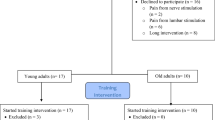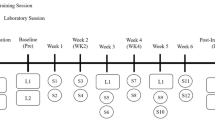Abstract
Multiple sclerosis (MS) patients suffer from impaired muscle activation and lower limb strength. Strength training enhances muscle activation and muscle strength, but neural adaptations to strength training remain unexplored in MS patients. The hypothesis was that maximal strength training (MST) using high loads and few repetitions would improve central neural drive and thus strength capacity of MS patients. 14 MS patients staying at a national MS rehabilitation center were randomly assigned to a MST group or a control group (CG). Both groups received “today’s treatment”. In addition, the MST group trained 4 × 4 repetitions of unilateral dynamic leg press and plantar flexion 5 days a week for 3 weeks. Neural adaptations of the soleus muscle were assessed by surface electromyography (EMG) activity, and by superimposed H-reflexes and V-waves obtained during maximum voluntary isometric plantar flexor contractions (MVCs). H-reflexes and V-waves were normalized by the M-wave (H SUP/M SUP, V/M SUP, respectively). In the MST group, MVC increased by 20 ± 9% (P < 0.05). Soleus EMG activity and V/M SUP ratio increased by 40 and 55%, respectively, in the MST group compared to the CG (P ≤ 0.05). The H SUP/M SUP ratio remained unchanged. No change was apparent in the CG. MST group subjects were able to complete all training sessions. No adverse effects were reported. This randomized study provides evidence that MST is effective of augmenting the magnitude of efferent motor output of spinal motor neurons in MS patients, alleviating some neuromuscular symptoms linked to the disease.



Similar content being viewed by others
References
Aagaard P (2003) Training-induced changes in neural function. Exerc Sport Sci Rev 31:61–67
Aagaard P, Simonsen EB, Andersen JL, Magnusson P, Dyhre-Poulsen P (2002a) Increased rate of force development and neural drive of human skeletal muscle following resistance training. J Appl Physiol 93:1318–1326
Aagaard P, Simonsen EB, Andersen JL, Magnusson P, Dyhre-Poulsen P (2002b) Neural adaptation to resistance training: changes in evoked V-wave and H-reflex responses. J Appl Physiol 92:2309–2318
Akima H, Takahashi H, Kuno SY, Masuda K, Masuda T, Shimojo H, Anno I, Itai Y, Katsuta S (1999) Early phase adaptations of muscle use and strength to isokinetic training. Med Sci Sports Exerc 31:588–594
Dalgas U, Stenager E, Jakobsen J, Petersen T, Hansen HJ, Knudsen C, Overgaard K, Ingemann-Hansen T (2009) Resistance training improves muscle strength and functional capacity in multiple sclerosis. Neurology 73:1478–1484
Dalgas U, Stenager E, Jakobsen J, Petersen T, Hansen H, Knudsen C, Overgaard K, Ingemann-Hansen T (2010) Fatigue, mood and quality of life improve in MS patients after progressive resistance training. Mult Scler 16:480–490
de Haan A, de Ruiter CJ, van Der Woude LH, Jongen PJ (2000) Contractile properties and fatigue of quadriceps muscles in multiple sclerosis. Muscle Nerve 23:1534–1541
de Souza-Teixeira F, Costilla S, Ayan C, Garcia-Lopez D, Gonzalez-Gallego J, de Paz JA (2009) Effects of resistance training in multiple sclerosis. Int J Sports Med 30:245–250
DeBolt LS, McCubbin JA (2004) The effects of home-based resistance exercise on balance, power, and mobility in adults with multiple sclerosis. Arch Phys Med Rehabil 85:290–297
Del Balso C, Cafarelli E (2007) Adaptations in the activation of human skeletal muscle induced by short-term isometric resistance training. J Appl Physiol 103:402–411
Duchateau J, Semmler JG, Enoka RM (2006) Training adaptations in the behavior of human motor units. J Appl Physiol 101:1766–1775
Duclay J, Martin A, Robbe A, Pousson M (2008) Spinal reflex plasticity during maximal dynamic contractions after eccentric training. Med Sci Sports Exerc 40:722–734
Fimland MS, Helgerud J, Gruber M, Leivseth G, Hoff J (2009a) Functional maximal strength training induces neural transfer to single-joint tasks. Eur J Appl Physiol 107:21–29
Fimland MS, Helgerud J, Solstad GM, Iversen VM, Leivseth G, Hoff J (2009b) Neural adaptations underlying cross-education after unilateral strength training. Eur J Appl Physiol (Epub ahead of print). doi:10.1007/s00421-009-1190-7
Fimland MS, Helgerud J, Knutsen A, Ruth H, Leivseth G, Hoff J (2010) No effect of prior caffeine ingestion on neuromuscular recovery after maximal fatiguing contractions. Eur J Appl Physiol 108:123–130
Gandevia SC (2001) Spinal and supraspinal factors in human muscle fatigue. Physiol Rev 81:1725–1789
Gaspari M, Roveda G, Scandellari C, Stecchi S (2002) An expert system for the evaluation of EDSS in multiple sclerosis. Artif Intell Med 25:187–210
Gondin J, Duclay J, Martin A (2006) Soleus- and gastrocnemii-evoked V-wave responses increase after neuromuscular electrical stimulation training. J Neurophysiol 95:3328–3335
Gutierrez GM, Chow JW, Tillman MD, McCoy SC, Castellano V, White LJ (2005) Resistance training improves gait kinematics in persons with multiple sclerosis. Arch Phys Med Rehabil 86:1824–1829
Hakkinen K, Kallinen M, Izquierdo M, Jokelainen K, Lassila H, Malkia E, Kraemer WJ, Newton RU, Alen M (1998) Changes in agonist-antagonist EMG, muscle CSA, and force during strength training in middle-aged and older people. J Appl Physiol 84:1341–1349
Henneman E, Somjen G, Carpenter DO (1965) Excitability and inhibitability of motoneurons of different sizes. J Neurophysiol 28:599–620
Hermens HJ, Freriks B, Disselhorst-Klug C, Rau G (2000) Development of recommendations for SEMG sensors and sensor placement procedures. J Electromyogr Kinesiol 10:361–374
Hoff J, Tjonna AE, Steinshamn S, Hoydal M, Richardson RS, Helgerud J (2007) Maximal strength training of the legs in COPD: a therapy for mechanical inefficiency. Med Sci Sports Exerc 39:220–226
Holtermann A, Roeleveld K, Engstrom M, Sand T (2007) Enhanced H-reflex with resistance training is related to increased rate of force development. Eur J Appl Physiol 101:301–312
Hortobagyi T, Hill JP, Houmard JA, Fraser DD, Lambert NJ, Israel RG (1996) Adaptive responses to muscle lengthening and shortening in humans. J Appl Physiol 80:765–772
Husby VS, Helgerud J, Bjorgen S, Husby OS, Benum P, Hoff J (2009) Early maximal strength training is an efficient treatment for patients operated with total hip arthroplasty. Arch Phys Med Rehabil 90:1658–1667
Kamen G, Knight CA (2004) Training-related adaptations in motor unit discharge rate in young and older adults. J Gerontol A Biol Sci Med Sci 59:1334–1338
Karlsen T, Helgerud J, Stoylen A, Lauritsen N, Hoff J (2009) Maximal strength training restores walking mechanical efficiency in heart patients. Int J Sports Med 30:337–342
Keenan KG, Farina D, Maluf KS, Merletti R, Enoka RM (2005) Influence of amplitude cancellation on the simulated surface electromyogram. J Appl Physiol 98:120–131
Knight CA, Kamen G (2001) Adaptations in muscular activation of the knee extensor muscles with strength training in young and older adults. J Electromyogr Kinesiol 11:405–412
Lagerquist O, Zehr EP, Docherty D (2006) Increased spinal reflex excitability is not associated with neural plasticity underlying the cross-education effect. J Appl Physiol 100:83–90
Milner-Brown HS, Stein RB, Lee RG (1975) Synchronization of human motor units: possible roles of exercise and supraspinal reflexes. Electroencephalogr Clin Neurophysiol 38:245–254
Narici MV, Roi GS, Landoni L, Minetti AE, Cerretelli P (1989) Changes in force, cross-sectional area and neural activation during strength training and detraining of the human quadriceps. Eur J Appl Physiol Occup Physiol 59:310–319
Ng AV, Miller RG, Gelinas D, Kent-Braun JA (2004) Functional relationships of central and peripheral muscle alterations in multiple sclerosis. Muscle Nerve 29:843–852
Noseworthy JH, Lucchinetti C, Rodriguez M, Weinshenker BG (2000) Multiple sclerosis. N Engl J Med 343:938–952
Paillard T (2008) Combined application of neuromuscular electrical stimulation and voluntary muscular contractions. Sports Med 38:161–177
Pierrot-Deseilligny E, Burke D (2005) The circuitry of the human spinal cord: its role in motor control and movement disorders. Cambridge University Press, New York
Rice CL, Vollmer TL, Bigland-Ritchie B (1992) Neuromuscular responses of patients with multiple sclerosis. Muscle Nerve 15:1123–1132
Romberg A, Virtanen A, Ruutiainen J (2005) Long-term exercise improves functional impairment but not quality of life in multiple sclerosis. J Neurol 252:839–845
Sale DG, MacDougall JD, Upton AR, McComas AJ (1983) Effect of strength training upon motoneuron excitability in man. Med Sci Sports Exerc 15:57–62
Scaglioni G, Ferri A, Minetti AE, Martin A, Van Hoecke J, Capodaglio P, Sartorio A, Narici MV (2002) Plantar flexor activation capacity and H reflex in older adults: adaptations to strength training. J Appl Physiol 92:2292–2302
Schieppati M (1987) The Hoffmann reflex: a means of assessing spinal reflex excitability and its descending control in man. Prog Neurobiol 28:345–376
Sharma KR, Kent-Braun J, Mynhier MA, Weiner MW, Miller RG (1995) Evidence of an abnormal intramuscular component of fatigue in multiple sclerosis. Muscle Nerve 18:1403–1411
Storen O, Helgerud J, Stoa EM, Hoff J (2008) Maximal strength training improves running economy in distance runners. Med Sci Sports Exerc 40:1087–1092
Suetta C, Aagaard P, Rosted A, Jakobsen AK, Duus B, Kjaer M, Magnusson SP (2004) Training-induced changes in muscle CSA, muscle strength, EMG, and rate of force development in elderly subjects after long-term unilateral disuse. J Appl Physiol 97:1954–1961
Taylor NF, Dodd KJ, Prasad D, Denisenko S (2006) Progressive resistance exercise for people with multiple sclerosis. Disabil Rehabil 28:1119–1126
Upton AR, McComas AJ, Sica RE (1971) Potentiation of “late” responses evoked in muscles during effort. J Neurol Neurosurg Psychiatry 34:699–711
Van Cutsem M, Duchateau J, Hainaut K (1998) Changes in single motor unit behaviour contribute to the increase in contraction speed after dynamic training in humans. J Physiol 513(Pt 1):295–305
Wang E, Helgerud J, Loe H, Indseth K, Kaehler N, Hoff J (2009) Maximal strength training improves walking performance in peripheral arterial disease patients. Scand J Med Sci Sports. doi:10.1111/j.1600-0838.2009.01014.x
White LJ, McCoy SC, Castellano V, Gutierrez G, Stevens JE, Walter GA, Vandenborne K (2004) Resistance training improves strength and functional capacity in persons with multiple sclerosis. Multiple Scler 10:668–674
Yao W, Fuglevand RJ, Enoka RM (2000) Motor-unit synchronization increases EMG amplitude and decreases force steadiness of simulated contractions. J Neurophysiol 83:441–452
Zehr PE (2002) Considerations for use of the Hoffmann reflex in exercise studies. Eur J Appl Physiol 86:455–468
Acknowledgments
The authors gratefully acknowledge the patients and staff at the MS centre in Hakadal for their effort. We also thank Karen Schei and Kirsti Stokkan for valuable help during the training of the patients.
Author information
Authors and Affiliations
Corresponding author
Additional information
Communicated by Arnold de Haan.
Rights and permissions
About this article
Cite this article
Fimland, M.S., Helgerud, J., Gruber, M. et al. Enhanced neural drive after maximal strength training in multiple sclerosis patients. Eur J Appl Physiol 110, 435–443 (2010). https://doi.org/10.1007/s00421-010-1519-2
Accepted:
Published:
Issue Date:
DOI: https://doi.org/10.1007/s00421-010-1519-2




